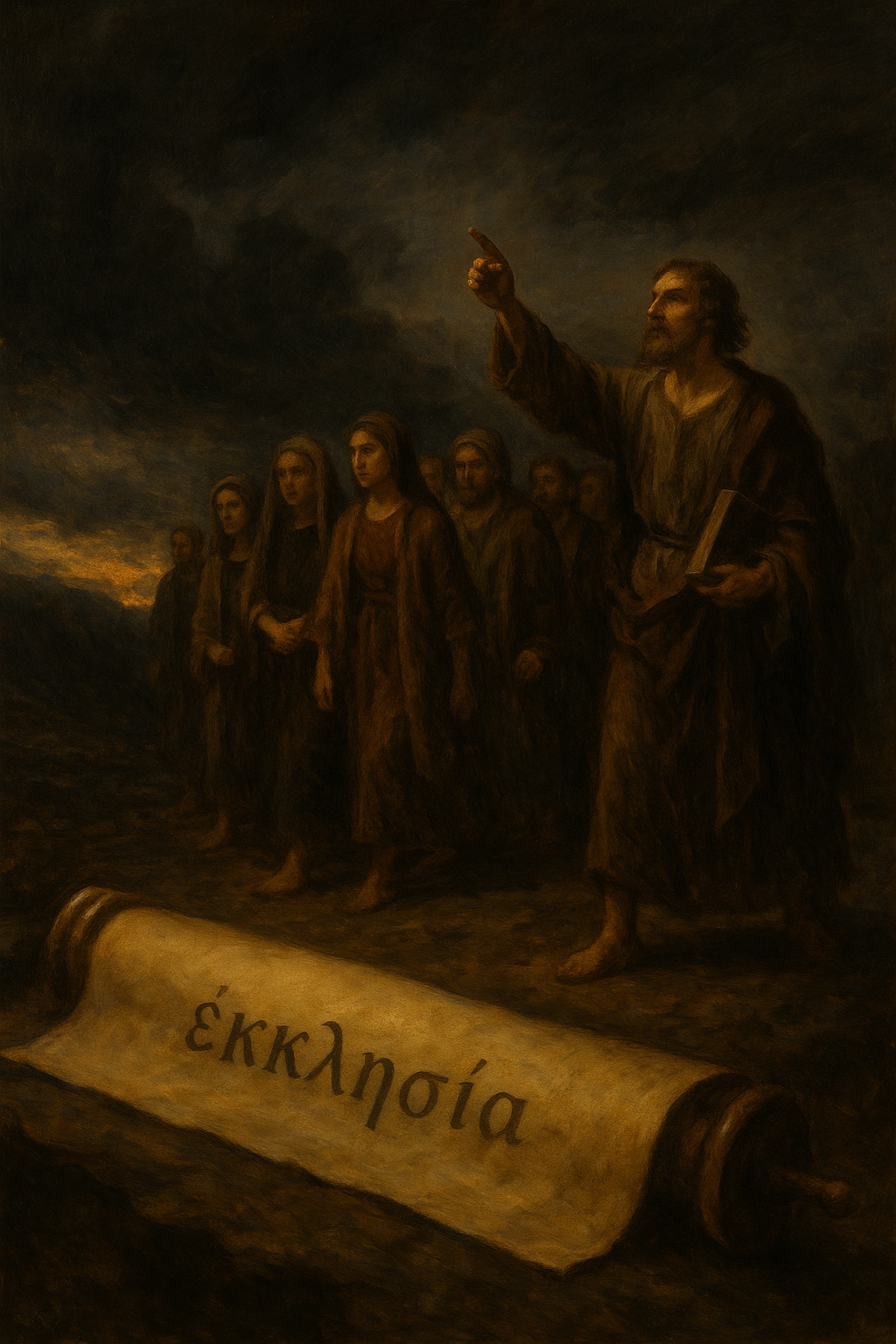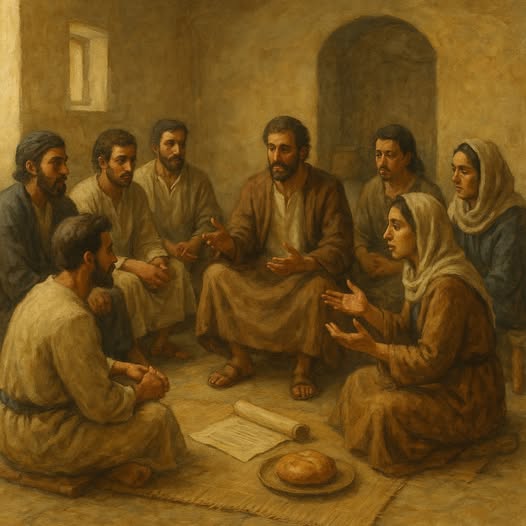
One of the most frequently used arguments by Pre-Tribulation Rapture advocates is that the Church—ekklesia in Greek—disappears after Revelation 3. They claim this proves the Church is no longer on Earth during the Tribulation, having been raptured beforehand. But does this argument hold up under scrutiny?
The Word “Church” in Revelation
The Greek word ekklesia, translated as “church,” appears nineteen times in the book of Revelation. All occurrences are found in chapters one through three, where Jesus gives specific messages to seven churches in Asia Minor. After this section, the word is not used again until Revelation 22:16, where Jesus says He sent the angel to testify “to the churches.”
Between Revelation 4 and 18, the chapters that describe the judgments, plagues, rise of the Beast, persecution of the saints, and the battle of Armageddon, the term ekklesia is completely absent. This omission is frequently interpreted by Pre-Tribulation proponents to mean that the Church must have been raptured before the Tribulation begins. However, this is an argument from silence, and it fails when examined more closely.
Silence Does Not Mean Absence
The disappearance of a word does not mean the disappearance of the people it describes. Ekklesia is a label, not a substance. Even though the term is not used after chapter three, the people who make up the Church are clearly still present throughout the rest of the book.
Revelation refers repeatedly to the Holy Ones, to those who keep the commandments of God and the faith of Jesus, to those who hold to the testimony of Jesus, and to those who come out of the great tribulation. These are unmistakably descriptions of faithful believers in Christ, which is what the Church is.
A Shift in Literary Style
The more likely explanation is that the focus of Revelation shifts. Chapters one through three are structured as direct letters to local churches, so the word ekklesia appears naturally. Revelation 4 through 19 transitions into apocalyptic prophecy, as found in Old Testament books such as Daniel and Ezekiel. As the genre shifts, so does the vocabulary.
Instead of using the language of church letters, John adopts Old Testament terms such as Holy Ones, servants, and witnesses. These are not new converts or some other group. These are faithful believers, described in the language of persecution and endurance used throughout Scripture. The change is literary, not theological.
Do Hagioi and Ekklesia Refer to Different Groups?
Some have suggested that the use of words like hagioi (holy ones) instead of ekklesia is intentional and reflects a new group of believers distinct from the Church. However, the term hagioi is neither new nor limited to some future class of believers. It has deep roots in both Old Testament and New Testament language to describe the faithful people of God.
In the Old Testament, holy ones (Hebrew: qedoshim, translated into Greek as hagioi in the Septuagint) appears repeatedly to describe God’s covenant people and also members of His divine council.
Deuteronomy 33:2 describes the Lord coming from Sinai “with myriads of holy ones.” Psalm 34:9 calls for God’s holy ones to fear Him. In Daniel 7, the “holy ones of the Most High” are persecuted by the little horn but are ultimately given the kingdom—language mirrored closely in Revelation 13 and 14.
In the New Testament, this term continues seamlessly. Believers in Christ are regularly referred to as hagioi. Romans 1:7 refers to the believers in Rome as Holy Ones. First Corinthians 1:2 greets the church of God in Corinth as “those sanctified in Christ Jesus, called to be Holy Ones.” Ephesians 1:1 addresses “the Holy Ones who are in Ephesus.” Paul even uses hagioi and ekklesia together in First Corinthians 14:33, writing, “As in all the churches of the Holy Ones.”
The overlap is unmistakable. The saints are the Church. The word hagioi does not signal a dispensational shift in Revelation. It is a long-standing biblical term used for God’s faithful people—first in the Old Testament, then throughout the New Testament. John’s use of it in Revelation continues this tradition and reflects the book’s strong connection to Old Testament prophetic and apocalyptic literature.
There is no biblical reason to assume that saints in Revelation are a new category of post-Church believers. They are the same faithful people of God, described in terms consistent with both testaments.
If the Church Is Gone, Who Are the holy ones?
If the Church had been raptured, we would expect to see a clear mention of it. But there is no rapture event described before the Tribulation begins. Instead, the text presents believers who endure suffering, persecution, and martyrdom under the reign of the Beast. If these are not members of the Church, then who are they?
Some suggest they are “Tribulation saints,” people who come to faith after the Church is taken away. But that idea is never stated in Revelation. There is no description of a great post-Rapture revival. There is no biblical basis for assuming that these saints are a distinct group separate from the Church.
Revelation 13:10 speaks of the endurance and faith of the saints. Revelation 14:12 describes those who keep God’s commandments and hold to faith in Jesus. These are not unbelieving Jews or recently converted Gentiles. This is the language Scripture uses to describe the faithful Church throughout the New Testament.
Revelation’s Message Is For the Churches
At the end of the book, Revelation 22:16 records Jesus saying, “I, Jesus, have sent my angel to testify to you about these things for the churches.” That statement does not refer only to the first three chapters. It refers to the entire vision—the judgments, the persecution, the rise and fall of the Beast, the return of Christ, and the restoration of all things. Jesus Himself says the whole book is for the churches.
If the Church were truly gone, this closing statement would make no sense. The vision is intended for the people who will be affected by it. It is not sealed off for a different group or future converts. It is addressed to the Church.
Conclusion
Yes, the word ekklesia disappears from Revelation after chapter three. But that does not mean the Church is gone. The focus of the book shifts into Old Testament-style prophecy, and the language changes accordingly. The faithful people of God are still present, though they are described as saints, witnesses, and those who follow the Lamb.
The argument that the Church has been raptured simply because the word “church” is not used is weak and based entirely on silence. The evidence in the text points in the other direction. The Church is not missing from the Tribulation. It is enduring it, remaining faithful to Christ, and awaiting His return in glory.
Discussion Questions
- Why is the absence of the word ekklesia after Revelation 3 not sufficient evidence for the Church’s removal from the Tribulation narrative?
- How does the shift in literary style from church epistles to Old Testament apocalyptic language affect the vocabulary used in Revelation?
- What is the significance of the term hagioi (“holy ones”) in both the Old and New Testaments?
- How does Revelation 22:16 challenge the claim that the Church is absent during the Tribulation?
- Who are the saints described in Revelation if they are not the Church?
Want to Know More?
- G. K. Beale – The Book of Revelation: A Commentary on the Greek Text. Series: New International Greek Testament Commentary. Publisher: Eerdmans, 1999.
Beale’s commentary is widely considered one of the most authoritative on Revelation. He argues strongly against the Pre-Tribulational reading and notes the literary and theological continuity of God’s people throughout the book. He gives careful attention to the Greek terms like ekklesia and hagioi, and emphasizes that Revelation draws heavily on Old Testament language. - Richard Bauckham – The Theology of the Book of Revelation. Publisher: Cambridge University Press, 1993.
Bauckham explores how Revelation uses Old Testament prophetic traditions and symbols, including its references to “holy ones.” He discusses how Revelation presents a unified people of God throughout the Tribulation, making no distinction between Israel, the Church, and so-called Tribulation saints. - Craig S. Keener – Revelation (NIV Application Commentary Series). Publisher: Zondervan, 2000.
Keener tackles the argument from silence regarding the absence of ekklesia in chapters 4–18 and explains why literary genre and allusion to Old Testament prophecy explain the change in terminology. He also emphasizes the call for endurance from believers during the Tribulation. - Michael S. Heiser – The Unseen Realm: Recovering the Supernatural Worldview of the Bible: Publisher: Lexham Press, 2015.
While not a commentary on Revelation specifically, Heiser provides deep background on the term holy ones (hagioi) and its roots in the Old Testament, including its dual use for divine beings and faithful humans. His work supports the argument that hagioi is a consistent biblical designation for God’s faithful, not something new in the Tribulation. - Ben Witherington III – Revelation and the End Times: Unraveling God’s Message of Hope. Publisher: Abingdon Press, 2010.
Witherington takes a narrative and theological approach to Revelation. He rejects the Pre-Tribulational rapture view, explaining the continuity of the people of God throughout the book and demonstrating how misreading symbols and genre leads to theological confusion.





